Discover the Best Places to Study French in Paris: From the Vibrant Montparnasse to the Cultural Hub of the Latin Quarter and the Charming Saint-Germain-des-Prés
Paris consists of 20 districts (“arrondissements”) that spiral out from the Ile de la Cité, the city’s historic center. The spiraling pattern resembles a snail’s shell. Parisians will routinely refer to the number of each arrondissement, so you should be familiar with their distinct nature.
Whether you are in Paris for vacation or business, you want to have everything you need within immediate walking distance: shops, sights, restaurants, cafés and that special Parisian street life. You will also want to be able to explore most of the desirable and reputed areas of central Paris on foot, without having to take the metro whenever you go out. Find out more about the best places to study French in Paris.
Montparnasse
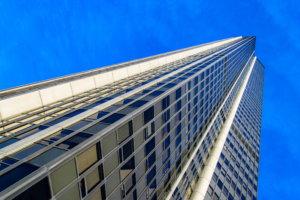
Today, Montparnasse is embodied by its tower, the central station and its many theaters. However, back in the years 1900s, and especially during the interwar years, it was the heart of the artistic and intellectual Parisian life, after Montmartre and just before the Saint-Germain-des-Prés’ area. Following Apollinaire, Gauguin and Matisse, many foreign artists went into exile in Paris to find favorable conditions to the development of their art. Modigliani, Zadkine, Chagall and many others formed then the “School of Paris”, a name that rather refers to a group of artists than a real artistic movement. Stroll around the neighbourhood and enjoy a breath of fresh air in the magnificent Jardins du Luxembourg, visit artists’ former homes, or one of the many museums: Musée Bourdelle, Musée Zadkine, Musée du Montparnasse… You may also visit the Catacombs (one of the most popular attractions in Paris), on the Place Denfert-Rochereau.
The Latin Quarter
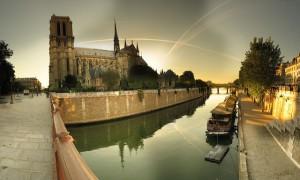
Located in the 5th district, the neighborhood is called the Latin Quarter after the language Sorbonne students once spoke here. The bustling boulevard St Michel hosted the famous student protests in May 1968 and the students are still there, hanging out mostly around the Place Saint Michel and its fountain, an area full of cheap and cheerful cafés, bars, shops, and small cinema revival houses. In addition to being one of the best places to study French in Paris, the district is home to many of France’s finest universities. Walking up the Boulevard, you will come to the Sorbonne, and the Pantheon where French luminaries are laid to rest. Walk on and discover the Place de la Contrescarpe and the excellent open market on the rue Mouffetard presenting the best selections of cheeses, fresh breads, and charcuterie. Going east, you will find the exotic botanical gardens, the Jardin des Plantes. You might even want to stop off at the exquisite Grande Mosquée de Paris with its impressive minaret for a steam bath and mint tea.
Saint Germain-des-prés
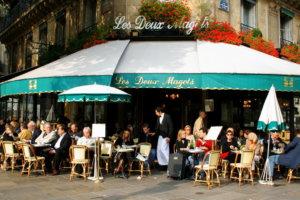
Saint Germain, located in the 6th district, around the oldest church in Paris, Saint-Germain-des-Prés, was once the epitome of Left Bank intellectual chic. Home to a number of famous cafés such as Les Deux Magots and Café de Flore, the Saint-Germain-des-Prés area was the center of the existentialist movement. You’ll pay twice as much for a coffee here, but that’s the price of history. Today it is more luxury than literary and full of high-end interior design stores and fashion boutiques. There are also many cinemas, bookshops, art galleries, and some of the city’s finest restaurants, cafés, and brasseries. St Germain is one of the most pleasant places to stroll. Wander around the cafés, flower markets, and shops at the Carrefour de Buci. The rue de l’Ancienne Comédie leads to the busy Place de l’Odéon and rue St-André des Arts where you can find the historic Cour du Commerce St-André (opposite No. 66), a fascinating cobbled passageway including Paris’s oldest café, Le Procope. There are several small museums including the impressive Musée Maillol, dedicated to the work of sculptor Aristide Maillol and the Musée Delacroix in charming Place Furstenburg. Not far away is the ‘Da Vinci Code’ Eglise St-Sulpice, where you can see two Delacroix frescoes. Be sure to visit the Luxembourg Gardens, one of the city’s most beautiful parks. The elegant Palais du Luxembourg regularly houses original and unusual art exhibitions. The rue de Rennes and the rue du Cherche Midi are great shopping streets. Don’t miss the Bon Marché department store at Sèvres Babylone, especially their huge Food Hall (La Grand Epicerie) where you will discover more French and international goodies than you knew existed.
Champs-Elysées
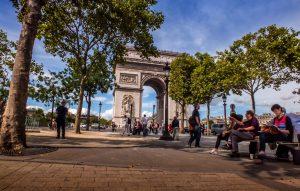
The Champs-Elysées, located in the 8th arrondissement (75008), remains the city’s – if not the world’s – most famous avenue and is a must to visit if you come to Paris over the Christmas season or on July 14th, the French national holiday. The avenue caters to everyone with fast-food joints and chain stores to luxury eateries like Ladurée. There are cinemas, discotheques and bars galore. At the top of the Champs-Elysées stands the imposing Arc de Triomphe, Napoléon’s monument to himself. Take a deep breath and climb to the top for an incredible view of the Etoile (star) of avenues below, circling the Arc de Triomphe. At the other end of the Champs, the beautifully restored Grand Palais hosts some of the city’s most splendid art exhibitions. Across the street, the permanent art collection is free at the Petit Palais. The Musée Jacquemart-André is also well worth a visit.
Montmartre
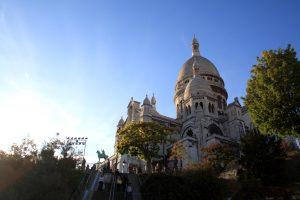
Montmartre, located in the 18th district, is famous for its artists and bohemians, cobbled alleys, staircases that pass for streets, and views of Paris from the Sacré Coeur, the late 19th century church resembling a wedding cake. Resident painters included Renoir, Picasso, van Gogh, and of course Toulouse-Lautrec. Montmartre until 1860 was a separate village with windmills and a vineyard. The rustic houses and narrow streets were never renovated and have kept their original charm and authenticity. Visit the busy Place du Tertre where you may want to have your portrait painted by one of the many street artists. The rue Lepic and Place des Abbesses are fun destinations for eating and drinking. Visit the Café des Deux Moulins (15 rue Lepic), the real-life café where the movie ‘Amélie’ was filmed. There are still shows at the tiny cabaret, the Lapin Agile, or you can venture down to Pigalle, the city’s largest red-light district and take in a show at the Moulin Rouge.
The Marais
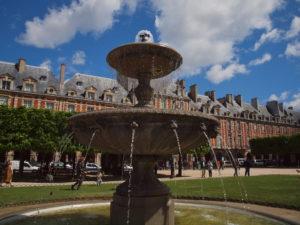
The historic Marais, spread over the 3rd and 4th districts, is perhaps the most popular choice for your stay. The narrow streets of historic heart of Paris are rich with a contrasting trendy and traditional population, while the wonderful patina of the 16th and 17th-century buildings is sharply enhanced by the designs and colors of as many boutiques. The 4e arrondissement, the Marais’s glitzier section, stretches between the Place des Vosges, one the city’s oldest and most romantic squares, and the provocatively multi-colored Pompidou Center, the sprawling modern art gallery towering over the centuries-old mansions of the area. The rue des Rosiers is still a major centre of the Paris Jewish community where delis and bakeries sell kosher food and falafels. Main sites of the neighborhood include the Musée Picasso, the wonderfully-restored Musée Cognaq-Jay, the Maison Européenne de la Photographie and the Musée Carnavalet. Don’t miss the back garden of the magnificent Hôtel de Sully. The northern half of Le Marais in the 3e arrondissement houses art galleries, trendy boutiques, and funky cafés and bars off the tourist track. Wander up the rue de Bretagne with its newly widened sidewalks, and stop at the Marché des Enfants Rouges (No. 39) – the oldest covered market in Paris. The areas to the east of the Marais around Bastille, République and rue Oberkampf are young and happening, coming alive at night with a varied club and bar scene.
Ile Saint Louis
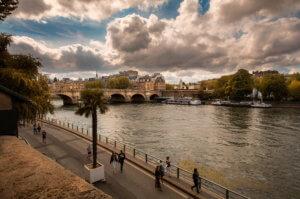
The Ile Saint Louis, located in the 4th district, is the smaller of the two islands in the center of Paris, joined by a bridge to the Ile de la Cité and Notre Dame. It is very residential and houses some magnificent ‘hôtels particuliers’ or town houses which are often tucked away in glorious, but hidden courtyards This tiny island is immensely popular with visitors and Parisians who enjoy eating ice-cream from the famous Berthillon shops, or lazing around on the banks of the Seine which surround the island. There are no major monuments or sites, just a few streets that make you feel like you’re in a village. There are many small hotels, restaurants, art galleries, and shops selling everything from jewellery to cheese and pâté. The island, first called the Ile aux Vaches “Cow Island,” as it was originally a grazing pasture, is named after King Louis IX or Saint Louis who, according to legend, came to pray before leaving on his last fatal Crusade in the 13th century.
Eiffel Tower
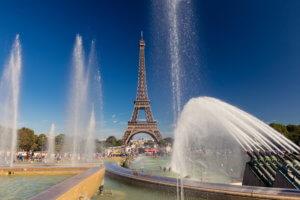
This upscale neighborhood, located in the 7th district, and overlooked by the Eiffel Tower, contains some of the most beautiful architecture in Paris with buildings proudly displaying their gloriously grand stone carvings. The airy, wide open avenues and boulevards are the antithesis of the somewhat cramped streets of the Marais. The Champs de Mars park, behind the Eiffel Tower, offers a stunning setting for reading, strolling, or just letting the kids vent their energy at the playground. The Place du Trocadero offers one of the best views of the Eiffel Tower. Be sure to go there at night when thousands of twinkling lights sparkle at the top of every hour and the rotating searchlight crosses the Paris night sky. There’s lots to visit besides the Eiffel Tower, including the Musée Rodin, Musée d’Orsay, Musée du Quai Branly, Hotel des Invalides and Ecole Militaire. The focal point of the area is the pedestrian rue Cler market, one of Paris’ best street markets and a true foody’s paradise. The adjoining streets, including rue Saint Dominique, are lined with great shops and a bewildering array of deliciously tempting restaurants and cafés.
Louvre / Historic center
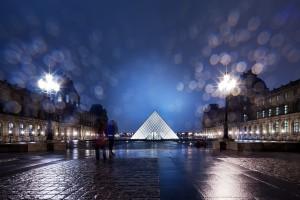
The Louvre, located in the 1st district in the center of Paris, is the largest national museum of France, the most visited museum in the world, and a historic monument. In the heart of the Louvre complex is the Pyramid situated above the underground visitor’s center where you can find stores and a food mall. The Louvre is closed on Tuesday. The nearby Musée des Arts Décoratifs on the rue de Rivoli is a must for those interested in design and objets d’art. The adjacent Tuileries Gardens are one of the city’s grandest walks and lead to the Jeu de Paume Museum, l’Orangerie which houses the famous Monet water lilies, and the Place de la Concorde. The Comédie Française stands at one corner of the Palais Royal, an arcaded 18th-century garden bordered by shops and restaurants. Lavish jewelers ring the Place Vendôme, fashion stores line the rue St Honoré, while more down-to-earth shopping takes place along the more accessible rue de Rivoli. To the east, Les Halles has changed from its origins as the city’s wholesale food market to a booming quarter with expensive apartments and trendy shops, cafés, and bars centered around the pedestrian streets Montorgueil and Montmartre.
Let us know what are your best places to study French in Paris!



Comments are closed.